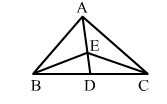The vertex A of ∆ABC is joined to a point D on the side BC. The midpoint of AD is E.
Prove that $\operatorname{ar}(\Delta B E C)=\frac{1}{2} \operatorname{ar}(\Delta A B C)$.

Given: D is the midpoint of BC and E is the midpoint of AD.
To prove: $\operatorname{ar}(\Delta B E C)=\frac{1}{2} \operatorname{ar}(\Delta A B C)$
Proof:
Since E is the midpoint of AD, BE is the median of ∆ABD.
We know that a median of a triangle divides it into two triangles of equal areas.
i.e., $\operatorname{ar}(\Delta B E D)=\frac{1}{2} \operatorname{ar}(\Delta A B D)$ .....(i)
Also, $\operatorname{ar}(\Delta C D E)=\frac{1}{2} \operatorname{ar}(\Delta A D C)$ .........(ii)
From (i) and (ii), we have:
$\operatorname{ar}(\Delta B E D)+\operatorname{ar}(\Delta C D E)=\frac{1}{2} \times \operatorname{ar}(\Delta A B D)+\frac{1}{2} \times \operatorname{ar}(\Delta A D C)$
$\Rightarrow \operatorname{ar}(\Delta B E C)=\frac{1}{2} \times[\operatorname{ar}(\Delta A B D)+\operatorname{ar}(\Delta A D C)]$
$\Rightarrow \operatorname{ar}(\Delta B E C)=\frac{1}{2} \times \operatorname{ar}(\Delta A B C)$
Click here to get exam-ready with eSaral
For making your preparation journey smoother of JEE, NEET and Class 8 to 10, grab our app now.
